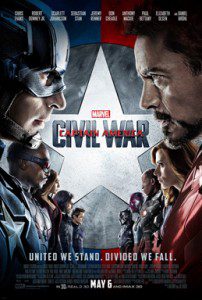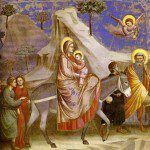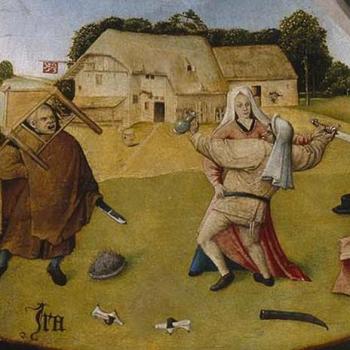
In comic books, and in movies based upon them, conflicts between heroes makes for great drama, and therefore, great stories. This year two major films, Batman Vs. Superman and Captain America: Civil War, have come out of this tradition.[1]
Perhaps a reason why such books and films are popular is that it allows fans to see which hero comes out when such conflicts occur, that is, who of them is to be seen as the best. It is the kind of thing which drives sports entertainment, this desire to see fan favorites struggling against each other, to prove their mettle and see which is able to come out on top. In the superhero tradition, such fights usually require heroes to be at the top of their form, thinking, fighting, dealing with each other at the height of their capabilities. They show us their inner character and drive, and how far they are willing to do for their rival points of view. Sometimes, in the process, heroes end up proving themselves superior in morality but lose the fight, while at other times it is because of their superior morality they are able to win. What is best is not always the strongest, most capable of overcoming someone else in a physical brawl, but in the end, it is this greater good which hopefully will persevere, if not in the battle, then in its aftermath.
Obviously, this is not always the case. The heroes live in a fallen world like the rest of us, and the taint of evil corrupts even the best. Good intentions are not always good enough, and so the struggle for what is good and best, individually as well as in a community, continues on, often creating more such conflicts as unresolved tensions remain between heroes.
How and why such heroes come to blows is a part of the interest in these tales. Sometimes, the fight is based upon mistaken beliefs and understandings, where one hero has been led to believe the other has turned away from heroism, turned evil, and needs to be stopped, often by any means necessary. When this happens, the dupe ends up fighting for the very evil which they want to prevent, and sometimes it is because of this, some heroes fall and later become villains. But such a fall from grace is rare. Usually, what happens is that the two come together, face each other off, and in the conflict the dupe learns how wrong they were to mistrust the other hero, allowing them to become friends (if they were not already), as they end up working together to counter the real evil which tried to lead them to destroy each other. Because such conflicts resolve without determining who among the two is the better hero, their fights tend to be the least interesting and the most easily resolved.
Better stories often develop when heroes, who both serve and follow some sort of moral vision, some sort of understanding of the good, find the good they represent in conflict with each other’s vision of the good. That is, when rival goods are at play, and it is difficult to know which good should take precedence, the fight ends up being more than just a physical battle between two good heroes who mistakenly fight each other, but rather, it is the fight of two heroes, both trying to be good, who are incapable of coming to a common ground to work out the differences in their vision of what that good entails. This also shows how good people can and do come to blows in the real world, and as a result, neither come out pure. In the comics, it is often left to the reader to determine which hero is more in the right (which is not always the one who wins the fight), while when we see such discord in history, we often rarely consider the “losing side” and what was lost as a result of such conflicts when they occur.
The moral ambiguity which led to such a fight demonstrates the limits in our understanding of the good itself, and should be used as a way to help us engage the question of the good, not by assuming we have an all-knowing eye of moral absolutes which allows us to know exactly what should be done, but with the realization we have to take the good and follow through with action in the real world with the eye of prudence. Wisdom and understanding is needed not only to avoid such conflicts, but to determine what happens once they are over. By seeing how this plays out in comic book fiction, where it is recognized that heroes can and do differ from each other, and find their good nature harmed as a result of their conflicts, we can better understand what plays out in the real world, when our real life heroes, those who represent the best of humanity, still have to deal with and play out the limitations contained in the human condition and its finitude. This helps us to deplore what a hero has done in some instances while still recognizing them to be a principled hero seeking after the good and worthy of the name hero.
Sometimes, disagreement between heroes is the result of a combination of the two kinds of conflict listed above. Rival good is pitted against rival good, and false information is given out by some third party in order to cause the heroes to fight, to divert the heroes attention from the real crisis which is about to occur. This third form of conflict shows us how absolutizing one’s own understanding of the good can lead one to accept such misdirection; indeed, pride is often at work here, where one is so led to believe in the absolute nature of the good they hold to, that they easily believe what lies are said by those who follow rival or conflicting visions of the good. In the trailers for Captain America: Civil War, the conflict between Steve Rogers and Tony Stark appears to come in part because of this: Tony ends up believing that the government needs to control the dangers inherent with the Avengers because of the way the Avengers seem to be going out of control when under the direction of Steve. And when Steve sees his friend, Bucky, being attacked, it does not take much for him to believe ill of those who would follow governmental order to take Bucky down. The conflict which develops therefore is based upon various goods which both Steve and Tony want to preserve and yet – underneath it, comes the interference of another source, someone seeking to undermine both of them, to have them destroy each other for his own insidious end. And this misdirection plays at the worst sides of Steve and Tony, such as when Tony seems jealous of Steve’s apparent physical perfection. What this kind of conflict represents and why it allows for a great amount of drama is it presents a major truth of the world which we must always confront: evil corrupts the good, distorts what it is through lies, and uses the corrupted vision of the good against the good itself. The good is hurt by the best of intentions because the limited vision of a particular good is unable to deal with the evil which endorses that particular good in its disordered rendering of the good itself.
What happens in the comics, with hero fighting against hero, is found especially in ecclesial history. Heroes, saints, often fight against other heroes, other saints. Rival conception of the good, rival viewpoints, rival theological opinions, have often led to bitter intra-ecclesial battles which no one comes out sparkling pure. It has been that way since the beginning of ecclesial history, when we see Paul often fighting other Apostles when he saw them engaging some error (such as when he confronted Peter for his uncharitable actions towards gentile converts, as recorded in Galatians 2:-11-3).
Probably one of the greatest examples of such a civil war in early ecclesiastical history is found in the so-called Origenist controversy in Alexandria. In its battle-lines we find Theophilus of Alexandria, St. Jerome, and St. Epiphanius fighting against Origenist monks in Egypt, the “Tall Brothers,” who, once kicked out and abused by Theophilus found aid and support in Constantinople with St. John Chrysostom. The war was waged on many battle lines, and lasted beyond the life of its instigators, as can be seen in the way St. Cyril of Alexandria, trying to work out the differences between Alexandria and Constantinople, nonetheless objected to those in Constantinople who wanted to commemorate the bishopric of St. John Chrysostom in Constantinople.
As for another example, we can turn to a point a bit later in history and see the conflict between Rome and St. Photius as another such civil war which showed some of the best and worst qualities of its participants. Rome backed St. Photius’s rival, St. Ignatius of Constantinople, as having legitimate claim to the see of Constantinople. While the intricate details of the rival claims are important, for us, what is more important is to see how this conflict helped both sides establish polemics which would later be used, out of context, to reify a breach in ecclesial unity and the bond of charity which should have remained between Rome and Constantinople. The terrible schism between the Rome and the “Catholics” with Constantinople and the “Orthodox” can be seen being played out in this miniature prelude; while both sides reconciled (St. Photius died in communion with Rome and was the one who established the sanctify of his rival, Ignatius), the worst impulses in this fight would eventually be reused to tear apart the Church.
Saints are human, and while they are heroes, they still battle the same instincts as the rest of us, and often fall to their worst instincts, just like the rest of us. And while they are praised for what they do which is good, we must be careful and not praise them for their mistakes. To be a saint, to be a person of heroic virtue, is a call for all of us. To see our saints as imperfect, imbalanced humans gives us the insight we need to never despair of our own potential sainthood if and when we see our own failings getting the best of us. And yet to understand this is also to make sure we look at the lives of the saints correctly, realizing we must not imitate them in all their actions, but only in the true and proper good which is established by them. The saints, like us, often failed when it came to properly engaging the good, and it was God’s grace which perfected them and lifted them out of themselves. It is grace which also perfects and our nature. It is God’s infinite love which lifts us up from our finite reflection of that love. God is able to take the imbalanced good found in us and bring it back into the good harmony he intends for it. Indeed, this is how his grace has worked in history, where he has helped correct the mistakes of the past, bringing back together those split apart, as well as how it works out in the eschaton, where we find those not reconciled in history reunited by finding themselves united together in the body of Christ. In this way, when we see in fiction the rivalry which can happen with different heroes with their differing conceptions of the good, we can realize good people can fight, disagree with each other, and yet still be worthy of the name hero. We can also see and understand that despite all the conflicts between heroes, between good people, however bad the conflicts were and should not have been, this does not take away from the good of those who truly were heroes. Heroes remain heroes, not because they have no moral failings and pettiness, but because there is something about them which pushes them, in some way or another, to transcend that failing and join themselves in the wider vision and activity of the real and proper good, which we, as Christians, know comes from God.
[1] I have not seen Batman Vs. Superman, and from the reaction of the fans, and of the plot details I’ve read, it does not interest me much (such fights have been done in the comics and previous animated films better). Captain America, on the other hand, I plan to see when it is released to the general public, and the reviews of it to date demonstrate that it is the kind of film which is worthy of its source material (from the Civil War series a decade ago), albeit one which changes the material greatly to demonstrate how the conflict works in the Marvel Cinematic Universe differs from what is found in the comic book universe. I do not expect Captain America to be shot and killed, nor do not expect much, if anything, will connect with as much oversight as was found in the “Mutant Registration Act,” but we do see that some of the themes remain the same. The government seems to be concerned about the dangers of the superheroes and want oversight, while many of the superheroes are concerned about the dangers implicit in such oversight and want independence from government control.
Stay in touch! Like A Little Bit of Nothing on Facebook:
A Little Bit of Nothing











